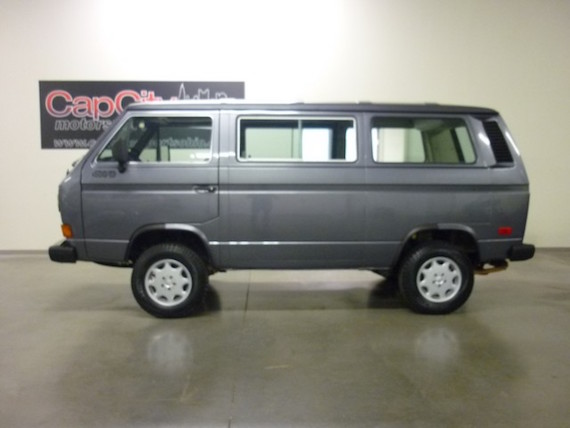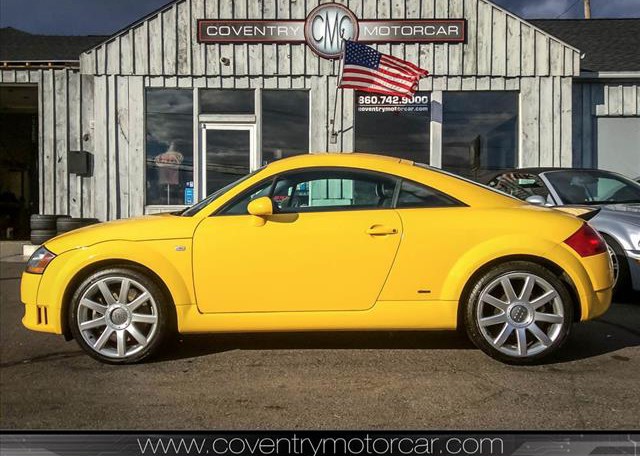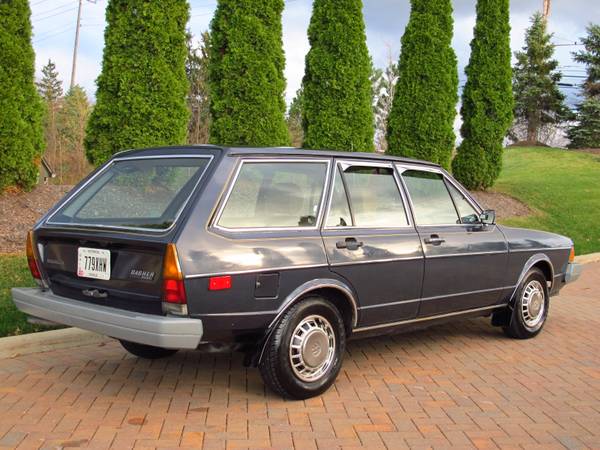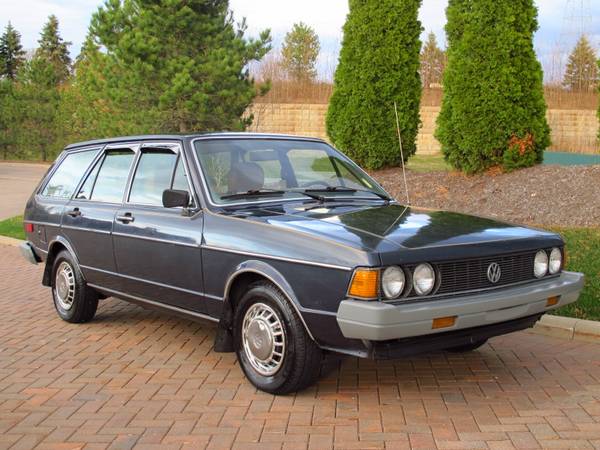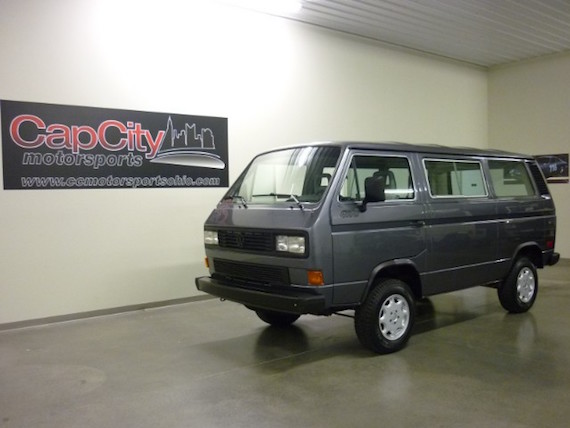
We’ve featured a few Tintop Syncros here before, and they present an interesting alternative to the more commonly seen (and voraciously desired) Syncro Westy. They lack the pop-top and its attendant hipness, height advantages, and sleeping space, but cut a slick line accentuating the box-on-wheels. The Syncro helps this out, lifting it up like the control cabin of an AT-AT in The Empire Strikes Back. Everything looks to be in order on this 95k-mile example, especially with new wheels, bumpers, and awning. It may be the 7-seat arrangement, making camper conversion a little more involved, but it could also serve as the coolest mountain shuttle out there.
Category: Volkswagen
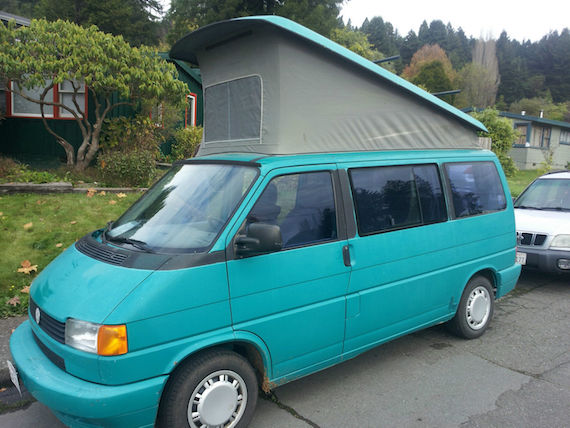
This weekend an old, rarely-seen but often kept in touch with friend came to the island I live on in his camper van. It’s a 2004 Ford E350, fully decked out with a kitchen, stand-up desk, futon, tons of storage, and a hightop so you can stand fairly comfortably. It reinspired my desire for a van that you can hang out in as you roadtrip. And while the draw to the Vanagon is well-documented, the later Eurovan has its charms. This 1993 Weekender is equipped with the classic Audi 5-cylinder (with classic Audi miles) and pop-top, but the weekender model eschews the kitchen for just a fold-out table and rear futon, but it’s a good base for trips shorter than a week. It’s an inexpensive way to get in on the van life, and a platform ripe for improvement as the years go on.
Click for details: 1993 Volkswagen Eurovan Weekender on eBay
Comments closedLong before “Dieselgate” and the unceremonious admission of Volkswagen about cheating on emissions testing, Volkswagen struggled with the image of diesel. The problem wasn’t as much air pollution – there was plenty of that – but it was that diesels were noisy and slow. How slow? Well, consider today’s 1980 Dasher Diesel Wagon, whose 1.5 inline-4 mill produced a twig-snapping 48 horsepower. Despite the relative light weight at only 2,500 lbs, the Dasher Diesel literally and figuratively lacked spark as it’s near 20-second 0-60 time proved. As gas prices fell and fuel injected gasoline engines became ever more efficient (and powerful), the gap between the fuel mileage to the diesels narrowed as the perceived benefit gulf of purchasing petrol widened. However, nearly 30 years before the introduction of the “Sport Wagon” TDi, you can still see the spiritual basis for Volkswagen’s popular 5-door diesel configuration.
The other day, a gentleman pulled up to me right after I parked my Passat. He rolled down the window and asked if I liked the car, then mentioned that it was lovely. I thanked him and said that I loved the car. Sure, even over a decade on B5.5 generation Passat Variants are a dime a dozen around the streets of New England. But while the B5.5 was by far the most popular choice for German wagons in the early 2000s, it wouldn’t be possible without the B1. Styled by Giugiaro, the new chassis completely redefined the platform for Volkswagen. It was followed by the niche but popular B2 (Quantum in the U.S.), then the odd-yet-cool B3, the more traditional B4 and finally the popular B5/5.5 chassis. With some sadness, the B6 would be the last wagon form of the Passat for U.S. customers, but it went out with a bang – being offered in 3.6 VR6 with 4Motion all-wheel drive. It was about as far from the original B1 as you could get, but the mission of each was the same and they were representative of their times. “We think you’ll agree Dasher is setting new standards for roomy wagons, with elegant appointments and fittings” touted the 1980 brochure, and it’s hard to argue that for some time the Passat was the best value not only in German wagons, but perhaps in family vehicles in total. While they were loved by their respective owner pools, they were also used, and each subsequent generation is steadily becoming more infrequent to see. B5s have already started to disappear while B4s rust away. B3s are downright rare, but not nearly as much as clean B2s. But a clean B1? I’d bet you could count the number of examples in this condition remaining on one hand:
CLICK FOR DETAILS: 1980 Volkswagen Dasher Diesel Wagon on Cleveland Craigslist
1 Comment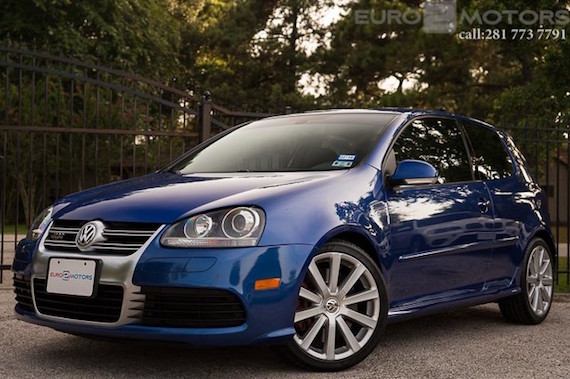
One week ago today I enthusiastically wrote up one of my preferred daydream cars, the original MkIV R32. When it came out, the R32 was the superGolf I’d always dreamed of but thought only existed in Hans Dahlback’s shop of terror. The MkIVs obviously still entice me today with wide fenders, deep growls, and a VR6/6-speed/4Motion combo that makes them very special hatchbacks indeed. Where I caught myself was trying to make an argument that MkIV prices have fallen far enough to be a great performance bargain.
MkIV R32s are certainly accessible hot hatch performance, but it’s not a bargain if you can get the following model, 4 years newer with nicer equipment, a little more power, and lightning-fast DSG for the same price. This MkV R32 brings all of that and fewer miles while still ringing in around $15k. The MkV may be in the running for the least desirable generation of Golfs, but the features outweigh the generational spite. With 250hp, all wheel drive, and a very sharp interior, this is an even better performance value than last week’s blue R32.
